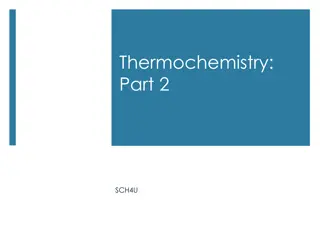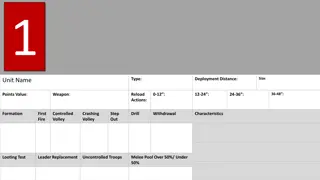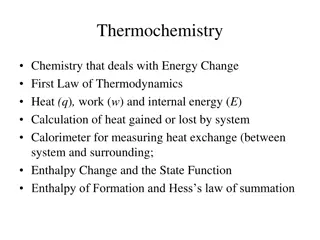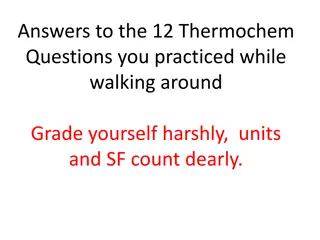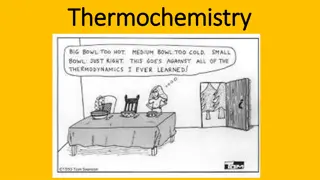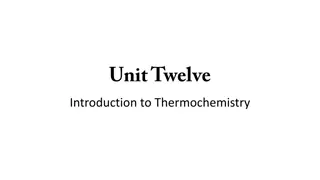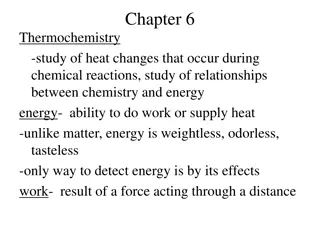
Understanding Changes and Properties of Matter
Explore the physical and chemical properties of matter, including physical changes like melting and boiling points, and chemical changes like corrosion and combustion. Learn about indicators of chemical reactions and differentiate between physical and chemical properties.
Uploaded on | 1 Views
Download Presentation

Please find below an Image/Link to download the presentation.
The content on the website is provided AS IS for your information and personal use only. It may not be sold, licensed, or shared on other websites without obtaining consent from the author. If you encounter any issues during the download, it is possible that the publisher has removed the file from their server.
You are allowed to download the files provided on this website for personal or commercial use, subject to the condition that they are used lawfully. All files are the property of their respective owners.
The content on the website is provided AS IS for your information and personal use only. It may not be sold, licensed, or shared on other websites without obtaining consent from the author.
E N D
Presentation Transcript
Changes and Properties of Matter
Physical Properties of Matter Physical Changes: Changes that change only the appearance of a substance, not its chemical identity. Physical Properties: Properties that can be observed through physical change
Physical Change Physical Property Melting point (the temperature at which a substance turns from a solid to a liquid) Boiling point (the temperature at which a substance turns from a liquid to a gas) Solubility (the amount of solute that can be dissolved in a solvent) Melting Boiling Dissolving Evaporating Vapor pressure (the pressure exerted by a vapor at vapor-liquid equilibrium) Malleability (the ability to be hammered or rolled into thin sheets) Crushing Stretching Ductility (the ability to be stretched into a wire) Density (the mass of a substance per unit volume) Electrical & Heat Conductivity (the ability to pass heat or electricity through a substance
Chemical Properties and Changes Chemical Changes: Changes that result in changing the chemical composition of a substance. Can be reversed only by another chemical change. Chemical Properties: Properties that can only be observed through chemical change.
Chemical Change Corrosion of metals, flammability Chemical Property Reactivity (the likelihood of one substance to undergo a chemical reaction with another substance) Stability (the likelihood that a substance will no decompose) Chemical decomposition e.g. hydrogen peroxide decomposes to form water and oxygen, but water does not decompose spontaneously Combustion releases heat (exothermic) Rarely do chemical changes absorb heat (endothermic) Heat of Reaction (the energy absorbed or released by a chemical reaction)
Indications of a chemical reaction: Energy absorbed or released (heat and/or light) Color change Gas production (bubbling, fizzing, or odor change) formation of a precipitate- a solid that separates from solution (won t dissolve) Irreversibility- not easily reversed new substances produced, old substances destroyed. 6 3/20/2025
Checking for understanding Explain why are these processes chemical changes: Burning paper Rusting bicycle Frying eggs Explain why are these processes physical changes: Boiling Condensation Shredding paper
Change in Energy
Energy Different types of energy exist (heat, potential, kinetic, chemical, nuclear etc.) Heat - the energy transferred between objects that are at different temperatures. Unit of heat is joules J. According to the Law of Conservation of Energy, energy cannot be created or destroyed. It can only by transferred or transformed. The total amount of energy in a system remains constant.
Add a potential energy diagram To draw from scratch Do more calculations on enthalpy/energies
Potential Energy Diagram http://www.kentchemistry.com/links/Kinetics/PEDiagrams.htm
Potential Energy Diagram Potential Energy Diagrams show changes in energy during chemical reactions. CHEMICAL EQUATIONS A + B ---> C + D Reactant Products In chemical reactions, reactants react to form products with an associated release or absorption of energy.
Change in Heat Energy 1. Exothermic Reaction The change in heat ( H) is NEGATIVE. Heat is released into the surroundings 2. Endothermic Reaction The change in heat ( H) is POSITIVE. Heat is absorbed by the system
Potential Energy Diagram Potential Energy in KJ N C O O O N C O O O Energy CO + NO2 REACTANTS C N O O O No unit, fancy of saying start to PRODUCTS finish Reaction Coordinate
Potential Energy Diagram Heat of Activated Complex Energy C CO + NO2 Heat of Reactants REACTANTS A PRODUCTS Heat of Products D Reaction Coordinate
Potential Energy Diagram N C O O O Activation Energy Amount of energy needed to start the reaction N C O O B O Energy CO + NO2 REACTANTS C N H O O O PRODUCTS H: ENTHALPY Net energy of the reaction Reaction Coordinate
Enthalpy (H)is used to quantify the heat flow into or out of a system in a process that occurs at constant pressure. H = H (products) H (reactants) H = heat given off or absorbed during a reaction at constant pressure Hproducts < Hreactants H < 0 Hproducts > Hreactants H > 0
Potential Energy Diagrams A catalyst is a substance that changes the speed of reactions by changing the activation energy. Catalysts speed up chemical reaction by lowering the activation energy Catalysts are not consumed during the reaction and can be recovered Activation Energy with no catalyst Potential Energy Activation Energy with a catalyst Enthalpy of Reaction Reaction Coordinate
Click Below for the Video Lectures Activation Energy Reaction Coordinate Catalyst
Exothermic and Endothermic
Exothermic Reaction A + B C + D + ENERGY a) Heat is released as a product. b) This heat is released into the environment surrounding the reaction, causing the temperature of the surroundings to increase. c) The products have less energy than the reactants after release. d) Since the products have less energy stored in their chemical bonds, they are more stable than the reactants were. Burning paper is exothermic. The ash formed by the burning is not flammable and will not burn.
General Exothermic Reaction A + B C + 70 kJ HA = 60 kJ HB = 40 kJ Hc = 30 kJ Energy Released as product Exothermic 100 KJ Law of conservation of energy states that the total energy of an isolated system cannot change.
Exothermic Reaction C (g) + O2 (g) CO2 (g) H = -393.5 kJ The minus sign in front of the enthalpy 393.5 kJ indicates that this reaction is exothermic, that energy was released. This energy can be placed on the products side, as follows: C (g) + O2(g) CO2(g) + 393.5 kJ
Synthesis C (g) + O2 (g) CO2 (g) H = -393.5 kJ Decomposition 1 mol of CO2 If we were to synthesize 2.3 moles of CO2, how many kJ would be released? 2.3 mol CO2 393.5 kJ = - 910 kJ 1 mol CO2 If Hsynthesis = - 393.5 kJ/mole, then Hdecomposition = +393.5 kJ/mole
Potential Energy Diagram - Exothermic A + B C + D + 40 kJ 150 Activation Energy = 150 70 80 KJ Energy H = 70 30 A + B - 40 kJ, released 70 REACTANTS C + D 30 PRODUCTS Reaction Coordinate
Endothermic Reaction A + B + ENERGY C + D a) Heat is absorbed by the reactants. b) This heat is absorbed from the environment surrounding the reaction, and the temperature of the surroundings decreases. c) The products have more energy than the reactants after absorption. d) This energy is stored in the chemical bonds of the products
General Endothermic Reaction A + B C + 50 kJ HA = 40 kJ HB = 20 kJ Hc = 110 kJ Energy absorbed as product Endothermic 60 KJ Law of conservation of energy states that the total energy of an isolated system cannot change.
Potential Energy Diagram - Endothermic A + B C + D + 40 kJ 150 Energy C + D 70 PRODUCTS Activation Energy = 150 30 80 KJ H = 70 30 A + B + 40 kJ, Absorbed 30 REACTANTS Reaction Coordinate
Click Below for the Video Lectures Exothermic and Endothermic
Calorimetry q = m C T Joules (J) Grams (g) J/goC oC units m is the mass of water in the calorimeter cup that absorbs heat from the change or releases heat to the change. C is the specific heat of water, the rate at which water gains or loses heat if energy is absorbed or removed from it. T is the Temperature change of the water in the calorimeter cup as a result of the physical or chemical change. q is the quantity of heat that is absorbed or released by a physical or chemical change What Each Variable Means
C Specific Heat The amount of heat required to raise the temperature of one gram of substance by one degree Celsius. cal/g C J/g C (or J/gK) water aluminum copper silver gold 1.00 0.22 0.093 0.057 0.031 4.18 0.90 0.39 0.24 0.13
Use this equation on the back of periodic table Specific Heat of water. Use the one for correct unit! They are NOT equations!!!
1. Circle the numbers, underline what you are looking for. 2. Make a list of number you circled using variables. 3. Write down the formula 4. Derive the formula to isolate the variable you are looking for. 5. Plug in the numbers How many joules are absorbed by 100.0 grams of water if the temperature is increased from 35.0oC to 50.0oC? q = mc T m = 100.0 g 35.0oC 50.0oC ? 4.18 j/goC T i= q = (100.0 g)(4.18 j/goC)(50.0oC- 35.0oC) T f= q = 6270 J q= C=
1. Circle the numbers, underline what you are looking for. 2. Make a list of number you circled using variables. 3. Write down the formula 4. Derive the formula to isolate the variable you are looking for. 5. Plug in the numbers 300. J of energy is absorbed by a 50. g sample of water in a calorimeter. How much will the temperature change by? q = mc T T = q / mc q = 300 J 50g ? 4.18 j/goC m = T = T = 300 J/ (50g)(4.18 j/goC) C= T = = 1.4354066 oC T = = 1.4oC
Checking for understanding 1. How many joules are required to raise the temperature of 100. grams of water from 20.0oC to 30.0oC ? 2. How many grams of water can be heated from 20.0oC to 75.0oC using 2500. J?
Calorimetry We use an insulated device called a calorimeter to measure this heat transfer. A typical device is a coffee cup calorimeter.
Calorimetry To measure H for a reaction 1.dissolve the reacting chemicals in known volumes of water 2.measure the initial temperatures of the solutions 3.mix the solutions 4.measure the final temperature of the mixed solution
Calorimetry The heat generated by the reactants is absorbed by the water. We know the mass of the water, mwater. We know the change in temperature, Twater. We also know that water has a specific heat of Cwater = 4.18 J/ C-g. We can calculate the heat of reaction by: qsys= H = qsurr = -mwater Cwater Twater
When 25.0 mL of water containing 0.025 mol of HCl at 25.0C is added to 25.0 mL of water containing 0.025 mol of NaOH at 25.0 C in a coffee cup calorimeter, a reaction occurs. Calculate H (in kJ) during this reaction if the highest temperature observed is 32.0 C. Assume the densities of the solutions are 1.00 g/mL. Knowns: Vfinal = VHCl + VNaOH = (25.0 + 25.0) mL = 50.0 mL Dwater = 1.00 g/mL Twater = Tfinal Tinitial = 32.0 C 25.0 C = +7.0 C Cwater = 4.18 J/ C-g Calculation: mwater = 50.0 g H = m C T = (50.0 g)(4.18 J/ C-g)(7.0 C) = 1463 J = 1.5 103 J
Phase Change Heating and Cooling Curve
Sublime Condense Freeze Evaporate Melt Gas Liquid Deposit Solid 42 3/20/2025
Phase Change During a phase change, there is a change in heat energy but no change in temperature. At the melting point, heat energy is being used to break down the crystalline lattice. At the boiling point, heat energy is being used to convert the liquid to a gas. During a phase change, heat is being used to change phase, not increase the kinetic energy of the particles. It is for this reason that Temperature remains constant in a phase change while heat energy changes.
LIQUID TO GAS GAS EVAPORATING BP Temperature MP D E SOLID to LIQUID LIQUID MELTING B C SOLID A Energy
Phase Change During phase change, temperature stays constant but energy increases.
Phase Change Energy needed to melt is called Latent Heat of Fusion ( Hfus) Energy need to vaporize is called Latent Heat of Vaporization ( Hvaporization)
Triple point the point on a phase diagram at which the three states of matter: gas, liquid, and solid coexist Critical point the point on a phase diagram at which the substance is indistinguishable between liquid and gaseous states
q = mCT q = mC T q = mC T








